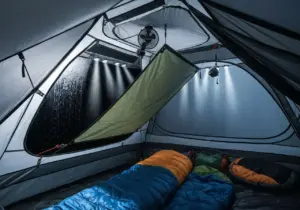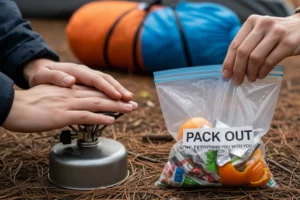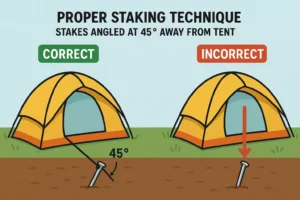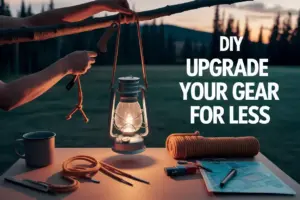Solo Camping for the First Time: Tips on Safety, Simple Meals, and Mindset
Picture this: you’re sitting by a crackling campfire under a blanket of stars, with nothing but the gentle sounds of nature surrounding you. No distractions, no schedules, just pure tranquility. Solo camping offers this magical experience, but for first-timers, the thought of venturing into the wilderness alone can feel overwhelming. The good news? With proper preparation and the right mindset, solo camping can become one of life’s most rewarding adventures.
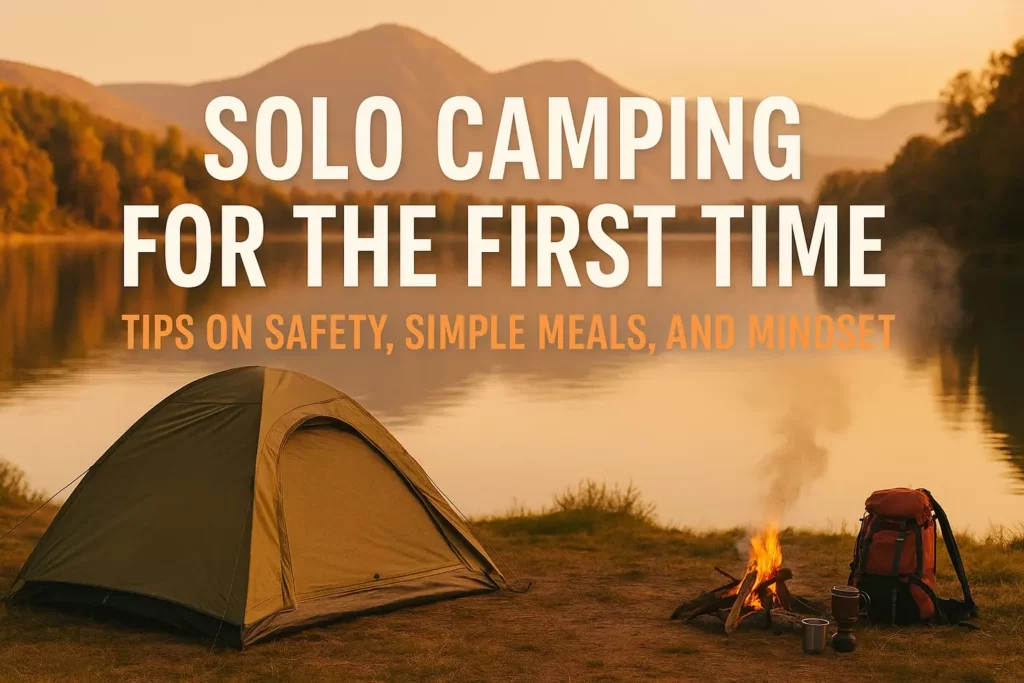
Whether you’re seeking solitude, personal growth, or simply want to disconnect from the digital world, solo camping provides an unmatched opportunity for self-discovery. However, camping alone requires extra attention to safety, meal planning, and mental preparation compared to group camping experiences.
Key Takeaways
- Safety first: Always inform someone of your plans, choose beginner-friendly spots, and pack essential safety gear including a comprehensive first aid kit
- Simple meal planning: Focus on easy-to-prepare, nutritious meals that require minimal cleanup and cooking skills
- Mental preparation: Embrace solitude gradually, bring entertainment options, and maintain a positive mindset
- Start small: Begin with car camping or established campgrounds before progressing to remote backcountry adventures
- Essential gear: Invest in quality equipment including proper shelter, navigation tools, and communication devices
Planning Your First Solo Camping Adventure
Choosing the Right Spot for Beginners
Selecting the perfect location for your first solo camping experience sets the foundation for success. Established campgrounds offer the ideal starting point for beginners, providing amenities like restrooms, potable water, and nearby assistance if needed.
State parks and national parks typically offer well-maintained facilities with clear trail markings and ranger presence. These locations provide the perfect balance between wilderness experience and safety infrastructure. Look for campgrounds that offer:
- Cell phone reception or emergency communication options
- Nearby water sources or provided water access
- Clear trail systems with proper signage
- Other campers in the vicinity (but not overcrowded)
- Reasonable distance from your vehicle
Car camping represents the most beginner-friendly approach, allowing easy access to your vehicle and gear. This setup eliminates the need for extensive backpacking equipment and provides a quick escape route if weather or circumstances change unexpectedly.
Essential Gear and Equipment
Creating a comprehensive gear list prevents forgotten essentials and ensures comfort during your solo adventure. Your equipment needs will vary based on season, location, and camping style, but certain items remain non-negotiable for solo campers.
Shelter and Sleep System:
- Weather-appropriate tent with proper ventilation
- Quality sleeping bag rated for expected temperatures
- Insulated sleeping pad for comfort and warmth
- Pillow or inflatable pillow for better rest
Safety and Navigation:
- First aid kit with personal medications
- Map and compass (plus GPS device or smartphone with offline maps)
- Whistle for emergency signaling
- Headlamp with extra batteries
- Multi-tool or knife
Cooking and Food Storage:
- Portable camping stove with extra fuel
- Lightweight cookware and utensils
- Food storage containers or bear canisters (where required)
- Water purification system
“The key to successful solo camping lies in thorough preparation. Every piece of gear should serve a purpose, and every essential should have a backup plan.” – Experienced Solo Camper
Solo Camping Safety Tips for Beginners
Pre-Trip Communication and Planning
Never venture into the wilderness without informing others of your plans. Create a detailed itinerary including your destination, planned routes, expected return time, and emergency contacts. Share this information with at least two trusted individuals who will know when to alert authorities if you fail to check in.
Establish a communication schedule with your emergency contacts. This might involve checking in via text message at predetermined times or calling when you reach specific milestones. Modern technology offers several options for remote communication:
- Satellite communicators for two-way messaging
- Personal locator beacons (PLBs) for emergency situations
- Smartphone apps with offline capabilities
- Traditional signaling devices (whistle, mirror, flare)
Campsite Safety and Security
Selecting and setting up a safe campsite requires careful consideration of environmental factors and security measures. Choose level ground away from potential hazards like dead trees, loose rocks, or flood-prone areas. Position your tent with the entrance facing away from prevailing winds while maintaining visibility of surrounding areas.
Food storage becomes critical when camping alone, especially in areas with wildlife activity. Follow Leave No Trace principles and local regulations regarding food storage. Use bear canisters, hang food properly, or store items in your vehicle if car camping.
Personal security measures include:
- Keeping a low profile and avoiding flashy gear displays
- Trusting your instincts about people and situations
- Maintaining awareness of your surroundings
- Having multiple exit strategies from your campsite
Wildlife Awareness and Prevention
Understanding local wildlife and their behaviors helps prevent dangerous encounters. Research the area’s common species and appropriate response protocols. Black bears, mountain lions, and other large mammals require specific safety measures and response strategies.
Prevention strategies include:
- Proper food storage and waste disposal
- Making noise while hiking to avoid surprising animals
- Keeping a clean campsite free of food odors
- Understanding animal behavior and warning signs
- Carrying appropriate deterrents (bear spray, noise makers)
Simple Solo Camping Meals and Food Planning
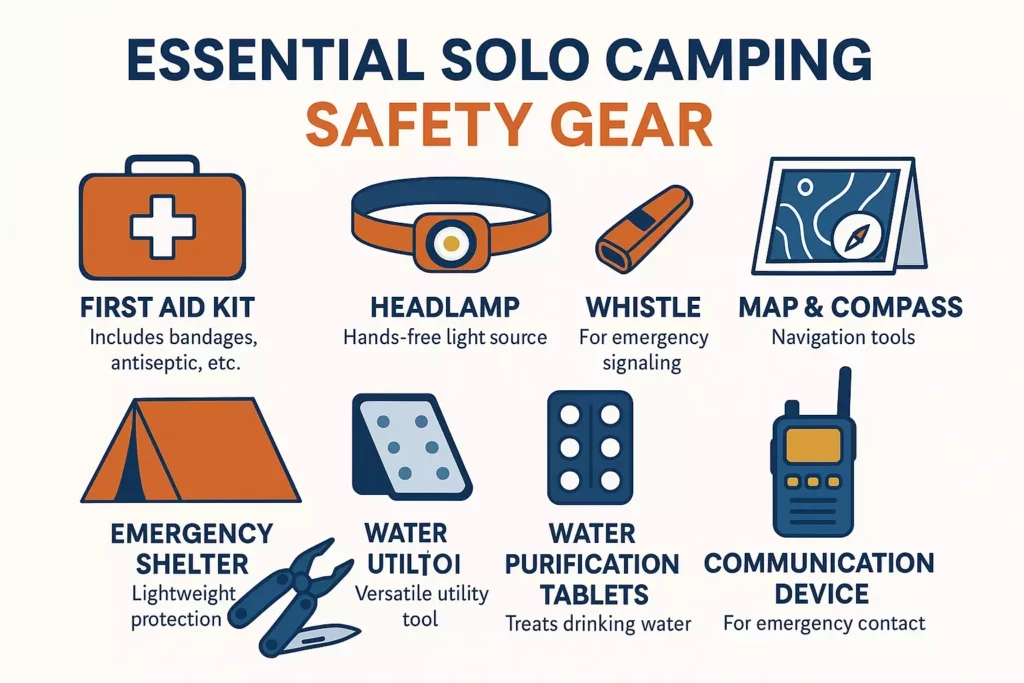
Easy Breakfast Ideas
Starting your day with a nutritious, energizing meal sets a positive tone for outdoor adventures. Solo camping breakfasts should be simple to prepare, require minimal cleanup, and provide sustained energy for activities.
Overnight oats represent the ultimate no-cook breakfast option. Combine rolled oats, dried fruits, nuts, and liquid (water or powdered milk) in a container before bed. Wake up to a ready-to-eat meal that requires zero morning preparation.
One-pot breakfast scrambles offer warm, satisfying meals with easy cleanup. Combine eggs (fresh or powdered), vegetables, cheese, and protein in a single pan. Popular combinations include:
- Scrambled eggs with dried tomatoes and cheese
- Breakfast hash with potatoes, peppers, and sausage
- Veggie scramble with spinach, mushrooms, and herbs
Quick breakfast options:
- Instant oatmeal with added nuts and dried fruit
- Granola with powdered milk
- Energy-packed breakfast burritos prepared ahead and reheated
- Peanut butter and banana on whole grain bread
Lunch and Dinner Solutions
No-cook lunch options eliminate the need for midday cooking and cleanup, perfect for active days exploring. Focus on foods that travel well and provide sustained energy:
- Wraps with hummus, vegetables, and protein
- Trail mix with nuts, dried fruits, and dark chocolate
- Crackers with cheese and cured meats
- Pre-made salads in sealed containers
Simple dinner recipes should require minimal ingredients and cooking skills while providing comfort after a day outdoors. One-pot meals minimize cleanup and cooking complexity:
Pasta dishes:
- Spaghetti with olive oil, garlic, and parmesan
- Mac and cheese with added vegetables
- Pasta salad with canned beans and vegetables
Rice-based meals:
- Fried rice with vegetables and eggs
- Rice and beans with spices
- Risotto made with instant rice and broth
Soup and stew options:
- Instant soup mixes with added vegetables
- Canned chili heated with fresh ingredients
- Ramen upgraded with eggs, vegetables, and protein
Food Storage and Preparation Tips
Meal planning for solo camping requires balancing nutrition, weight, and storage considerations. Plan meals that share ingredients to minimize waste and weight. For example, use the same vegetables across multiple meals and choose versatile proteins that work in various dishes.
Food safety becomes more critical when camping alone, as foodborne illness can create dangerous situations. Follow these guidelines:
- Keep perishables cold with adequate ice or refrigeration
- Cook foods to proper temperatures
- Consume opened items quickly
- Dispose of leftovers properly to avoid attracting wildlife
Storage solutions:
- Lightweight, stackable containers for organization
- Vacuum-sealed bags for space efficiency
- Coolers with good insulation for car camping
- Bear canisters or proper hanging techniques for backcountry
Developing the Right Mindset for Solo Camping
Embracing Solitude and Overcoming Fears
Solo camping challenges many people’s comfort zones, particularly those accustomed to constant social interaction and digital connectivity. The key to success lies in gradually building comfort with solitude and developing confidence in your outdoor skills.
Start small with your solo adventures. Begin with day hikes alone, progress to overnight car camping, then gradually work toward more remote experiences. This progression builds confidence while allowing you to identify and address comfort zones at a manageable pace.
Common fears and their solutions:
- Fear of wildlife: Education about local species and proper safety measures
- Fear of getting lost: Navigation skills practice and backup systems
- Fear of medical emergencies: First aid training and communication devices
- Fear of loneliness: Mental preparation and entertainment options
Mental Preparation Strategies
Mindfulness and meditation practices enhance the solo camping experience while providing tools for managing anxiety or stress. The natural environment offers an ideal setting for practicing present-moment awareness and connecting with your surroundings.
Positive self-talk becomes crucial when facing challenges alone. Develop mantras or affirmations that reinforce your capabilities and decision-making skills. Remember that feeling nervous about new experiences is normal and doesn’t indicate inability to handle the situation.
Goal setting for your solo camping trip helps maintain focus and provides measurable achievements. Goals might include:
- Completing a specific hiking trail
- Trying a new camping skill or recipe
- Spending a certain amount of time without digital devices
- Observing and identifying local wildlife or plants
Entertainment and Activities for Solo Campers
Quiet activities complement the peaceful nature of solo camping while providing entertainment during downtime. Consider bringing:
- Books or e-readers for evening entertainment
- Journals for reflection and trip documentation
- Sketch pads for artistic expression
- Photography equipment for capturing memories
- Musical instruments (harmonica, ukulele) for personal enjoyment
Nature-based activities enhance your connection with the environment:
- Bird watching and wildlife observation
- Plant identification and nature photography
- Star gazing and constellation identification
- Geocaching or treasure hunting
- Meditation and yoga practice
Skill-building opportunities:
- Practicing knots and rope work
- Fire building and maintenance techniques
- Navigation and map reading
- Bushcraft and survival skills
- Weather prediction and observation
Weather Considerations and Seasonal Planning
Understanding Weather Patterns
Weather awareness becomes crucial for solo campers who lack the support system of group decision-making. Understanding basic meteorology and weather prediction helps you make informed decisions about trip timing, gear selection, and safety protocols.
Seasonal considerations affect every aspect of solo camping from gear requirements to food storage and safety concerns. Spring camping offers mild temperatures but potential for sudden weather changes and muddy conditions. Summer provides the most predictable weather but brings challenges like heat, thunderstorms, and increased wildlife activity.
Fall camping rewards adventurers with beautiful foliage and comfortable temperatures while requiring preparation for rapidly changing conditions. Winter camping demands advanced skills, specialized gear, and extensive safety planning.
Gear Adaptation for Different Conditions
Layered clothing systems provide versatility for changing weather conditions throughout your trip. The three-layer system includes:
- Base layer: Moisture-wicking materials that keep skin dry
- Insulating layer: Fleece or down for warmth retention
- Shell layer: Waterproof/breathable protection from wind and rain
Proper clothing selection can mean the difference between comfort and misery during unexpected weather changes. Avoid cotton materials that retain moisture and lose insulating properties when wet.
Shelter considerations vary dramatically based on expected conditions. Three-season tents work well for most beginner solo camping situations, while four-season tents become necessary for winter or extreme weather camping.
Building Confidence Through Progressive Experiences
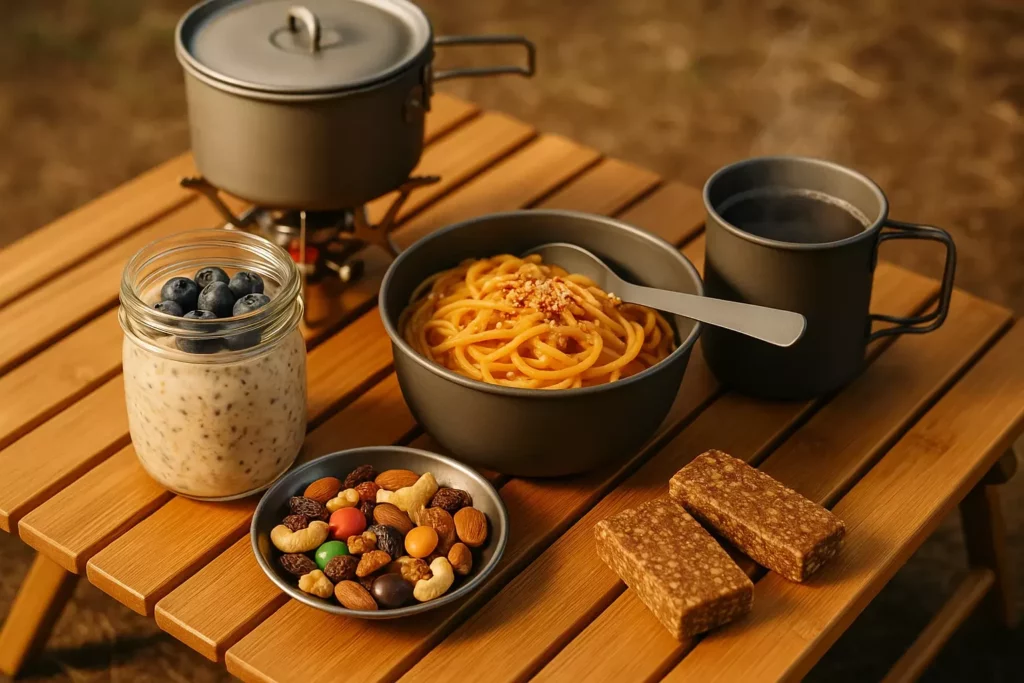
Starting with Car Camping
Car camping provides the perfect introduction to solo outdoor experiences while maintaining access to safety and comfort. This approach allows you to test gear, practice camp setup, and build confidence without the added complexity of backpacking logistics.
Advantages of car camping for beginners:
- Easy access to additional gear and supplies
- Quick retreat option if weather or circumstances change
- Ability to bring comfort items that boost confidence
- Practice opportunity for camp cooking and setup
Setting up your first camp becomes much easier when you can take your time and access all your gear easily. Use car camping trips to perfect your setup routine and identify any gear gaps or issues.
Progressing to Backcountry Adventures
Backpacking solo represents the ultimate wilderness experience but requires advanced preparation and skills. Before attempting overnight backpacking trips, gain experience with day hiking, navigation, and lightweight gear systems.
Essential skills for backcountry solo camping:
- Navigation with map and compass
- Leave No Trace principles and ethics
- Water procurement and purification
- Emergency signaling and self-rescue techniques
- Weather assessment and decision-making
Progressive skill building:
- Day hikes with full backpack to test gear and fitness
- Overnight trips near trailheads or with easy exit options
- Multi-day adventures in familiar areas
- Remote wilderness experiences with advanced route planning
Learning from Each Experience
Trip documentation helps you learn from each experience and improve future adventures. Keep a camping journal that includes:
- Gear performance and needed modifications
- Weather conditions and how they affected your trip
- Meals that worked well and those that didn’t
- Challenges faced and how you solved them
- Highlights and memorable moments
Gear refinement occurs naturally as you gain experience and understand your personal preferences and needs. What seems essential for your first trip may prove unnecessary, while items you initially overlooked become must-haves.
Skill development continues throughout your solo camping journey. Each trip provides opportunities to practice existing skills and learn new ones. Consider taking courses in wilderness first aid, navigation, or outdoor leadership to enhance your capabilities.
Emergency Preparedness and Risk Management
Creating Emergency Action Plans
Risk assessment forms the foundation of safe solo camping. Before each trip, identify potential hazards including weather, terrain, wildlife, and personal health factors. Develop specific response plans for likely scenarios.
Communication protocols ensure help can find you when needed. Establish check-in schedules with emergency contacts and stick to them religiously. Late check-ins should trigger predetermined escalation procedures.
Emergency gear should include:
- Signaling devices (whistle, mirror, flare)
- Emergency shelter (bivy sack, emergency blanket)
- Fire starting materials in waterproof container
- Emergency food and water supplies
- Personal medications and first aid supplies
Self-Rescue Techniques
Basic first aid skills become critical when help is hours or days away. Take a wilderness first aid course that covers common outdoor injuries and illnesses. Practice skills regularly to maintain proficiency.
Navigation skills prevent many emergency situations. Learn to use map and compass effectively, and always carry backup navigation methods. GPS devices can fail, but traditional navigation tools remain reliable.
Survival priorities follow the “rule of threes”:
- 3 minutes without air
- 3 hours without shelter in harsh conditions
- 3 days without water
- 3 weeks without food
Understanding these priorities helps you focus efforts appropriately during emergency situations.
Solo Camping Ethics and Environmental Responsibility
Leave No Trace Principles
Environmental stewardship becomes more important when camping alone, as you bear full responsibility for your impact. Follow all seven Leave No Trace principles:
- Plan ahead and prepare
- Travel and camp on durable surfaces
- Dispose of waste properly
- Leave what you find
- Minimize campfire impacts
- Respect wildlife
- Be considerate of other visitors
Waste management requires careful planning when camping solo. Pack out all trash, including food scraps and toilet paper. Use established toilet facilities when available, or follow proper backcountry waste disposal techniques.
Wildlife Protection
Food storage protects both wildlife and campers. Animals that become habituated to human food often become aggressive and may need to be relocated or destroyed. Use bear canisters, hang food properly, or store items in vehicles as required by local regulations.
Wildlife observation should maintain appropriate distances and avoid disturbing natural behaviors. Use binoculars or telephoto lenses for close-up viewing, and never feed wild animals.
Habitat protection includes staying on designated trails, camping in established sites when possible, and avoiding sensitive areas during breeding seasons or harsh weather periods.
Building Community and Sharing Experiences
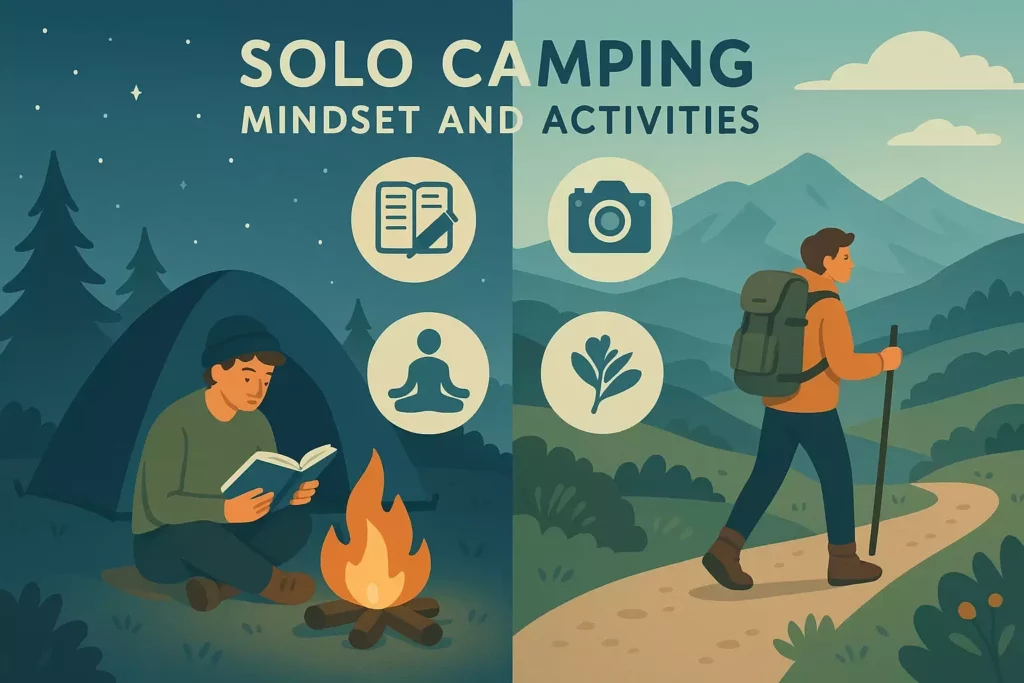
Connecting with Other Solo Campers
Online communities provide valuable resources for solo campers including trip reports, gear reviews, and safety tips. Participate in forums, social media groups, and outdoor clubs to learn from experienced solo adventurers.
Local outdoor clubs often organize group trips that can help you develop skills and confidence for solo adventures. Many clubs also offer skills workshops and training opportunities.
Mentorship opportunities exist both as a mentee learning from experienced campers and eventually as a mentor sharing your knowledge with newcomers to solo camping.
Sharing Knowledge and Experiences
Trip reports help other solo campers by sharing route information, gear recommendations, and safety considerations. Write detailed reports that include both successes and challenges.
Photography and documentation can inspire others to try solo camping while showcasing the beauty and rewards of wilderness solitude. Share images and stories that highlight both the adventure and responsibility aspects of solo camping.
Skills sharing through workshops, blog posts, or informal mentoring helps build a stronger, safer solo camping community. Teaching others also reinforces your own knowledge and skills.
Conclusion
Solo camping offers unparalleled opportunities for personal growth, self-discovery, and deep connection with nature. While the prospect of venturing into the wilderness alone may seem daunting initially, proper preparation, gradual skill building, and the right mindset make solo camping accessible to beginners.
Success in solo camping stems from thorough preparation across multiple areas: safety planning, gear selection, food preparation, and mental readiness. Start with car camping at established campgrounds to build confidence and refine your systems before progressing to more remote adventures.
Safety remains paramount throughout your solo camping journey. Always inform others of your plans, carry appropriate safety gear including a well-stocked first aid kit, and develop the skills necessary for self-reliance in the outdoors. Remember that turning back or changing plans due to conditions shows wisdom, not weakness.
The rewards of solo camping extend far beyond the immediate outdoor experience. Many solo campers report increased confidence, better problem-solving skills, and a deeper appreciation for both solitude and human connection. The skills you develop and the self-reliance you build serve you well both in the outdoors and in daily life.
Take action today by planning your first solo camping adventure. Start small with a single night at a nearby campground, focus on simple meals and basic gear, and embrace the learning process. Each experience builds toward greater adventures and deeper wilderness connections.
Whether you’re seeking stress relief, personal challenge, or simply a break from digital connectivity, solo camping provides a pathway to these goals. With proper preparation and a positive mindset, your first solo camping experience can be the beginning of a lifelong adventure in outdoor self-reliance and natural wonder.


